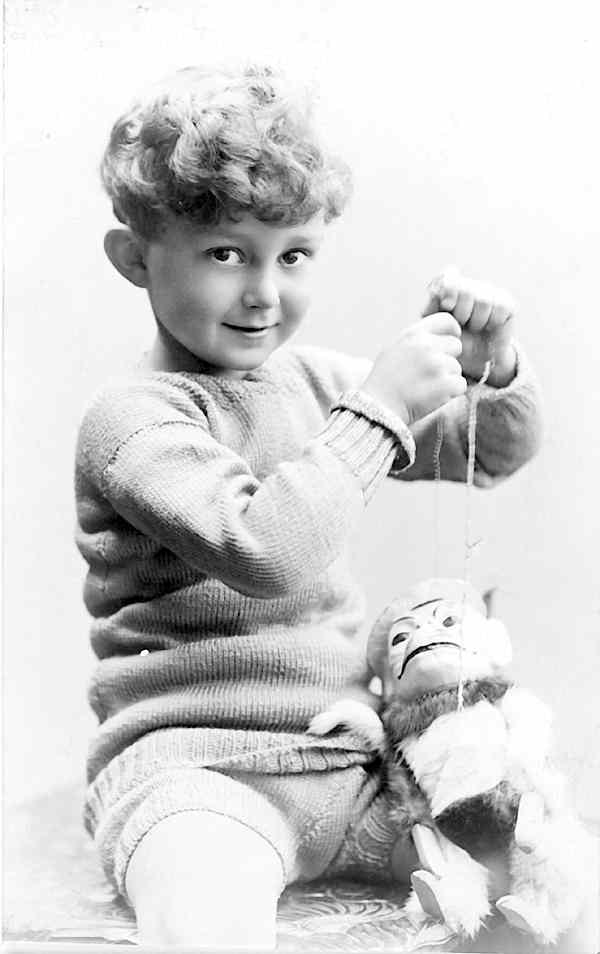
English Boys Knitted Wear: Knitsuits

Figure 1.--This English boy is playing with his marionette. He looks to be about 5 years old and is wearing a short pants knitted suit. I'm not sure about the color. The image is udates, but was probably taken in the 1920s. This was probably a hand-knitted outfit. Image courtesy of the MD collection.
|
We believe English boys were wearing knit suits in the late 19th century, but do not have images to substantiate this. We do have images the turn of the century. The oldest image in our archive is dated 1915, but we believe they were worn earlier. Some of these outfits are clearly hand made. Even by 1915, however, we believe there were ready made knit suit outfits available. Many of these suits were hand made and knitting catalogs offered amy different patterns to choose from. These knit suit outfits appear to have been very popular in england from the 1920s through the 1960s. We note many differet styles, especially with the collars. Most of the English knitsuit sets were short pants outfits until after World War II. The suits were generally solid colors suits until after World War II. I am not sure what the popular colors were.
Image
The boy here is unidentified and the image undated. He seems to be preschool age, perhaps 5 years old. The curly hair style was probablu natural and popular for younger boys at the time. The obvious seams in the sweater and shorts suggest that this outfit was knitted by hand. A HBC reader points out, "Lovely image. Notice how relaxed (casual) the composition is in comparison to many pre-World War I images from Europe."
Chronology
We believe English boys were wearing knit suits in the late 19th century, but do not have images to substantiate this. We do have images the turn of the century. The oldest image in our archive is dated 1915, but we believe they were worn earlier. These knit suit outfits appear to have been very popular in England from the 1920s through the 1960s. We wonder if some English women did not perfect their knitting skills during World War I.
Some of these outfits are clearly hand made. Even by 1915, however, we believe there were ready made knit suit outfits available. Many of these suits were hand made. Some knit suits were obviously hand knitted. Some mothers, of course, were more skilled than others. In other instances it isuite difficult to tell. Clearing vissible seams, for example, were an indication that they outfits were hand made. The claerly visible seams seen in the image here are an indicatio that this was a hand knitted outfit. These knit suits were a popular item for younger boys in knitting catalogs and as a result there were a variety of patterns.
Knitting Catalogs
We are not yet sure about the principal knitting catalogs offered amy different patterns to choose from.
We note many differet styles, especially with the collars. Many hand knitted suits did not havde collars and were simple pullovers. Collars added a level of complication to the knittng that was beyond the skills of some mothers. We have also seen these seen these suits with complicated collars. Some were collars similar to modern knit shirts. Other had buttons at the shoulders rather like some tunic or smock styles. This was a popular style as it made a little easier to dress the younger boy.
Types
Most of the English knitsuit sets were short pants outfits until after World War II. Eraly knit suits were quite lng to knee length. The pants became much shorter after World War I in the 1920s.
Patterns
The suits were generally solid colors. We see very few pattern designs until after World War II.
Colors
I am not sure what the popular colors were.
Christopher Wagner

Navigate the Boys' Historical Clothing Web Site:
[Return to the Main knitsuit country page]
[Knits]
[Socks]
[Tams]
[Sweaters]
Navigate the Boys' Historical Clothing Web Site:
[Introduction]
[Activities]
[Biographies]
[Chronology]
[Clothing styles]
[Countries]
[Essays]
[Bibliographies]
[Contributions]
[FAQs]
[Glossary]
[Satellite sites]
[Tools]
[Boys' Clothing Home]
Created: January 29, 2003
Last updated: January 30, 2003



